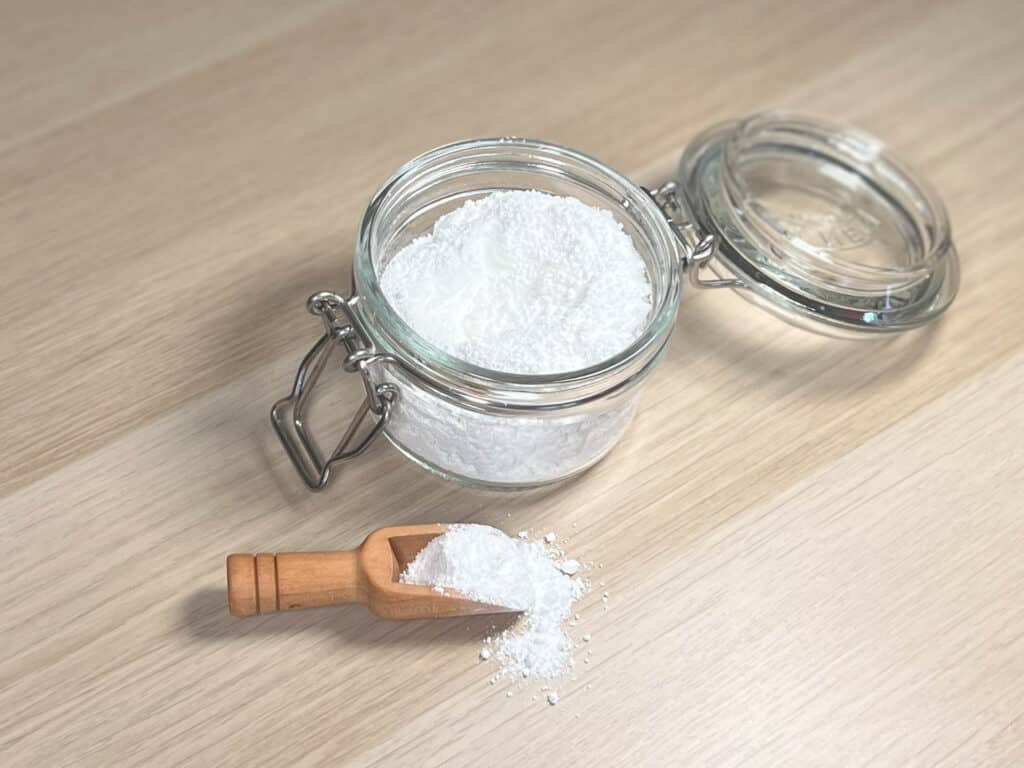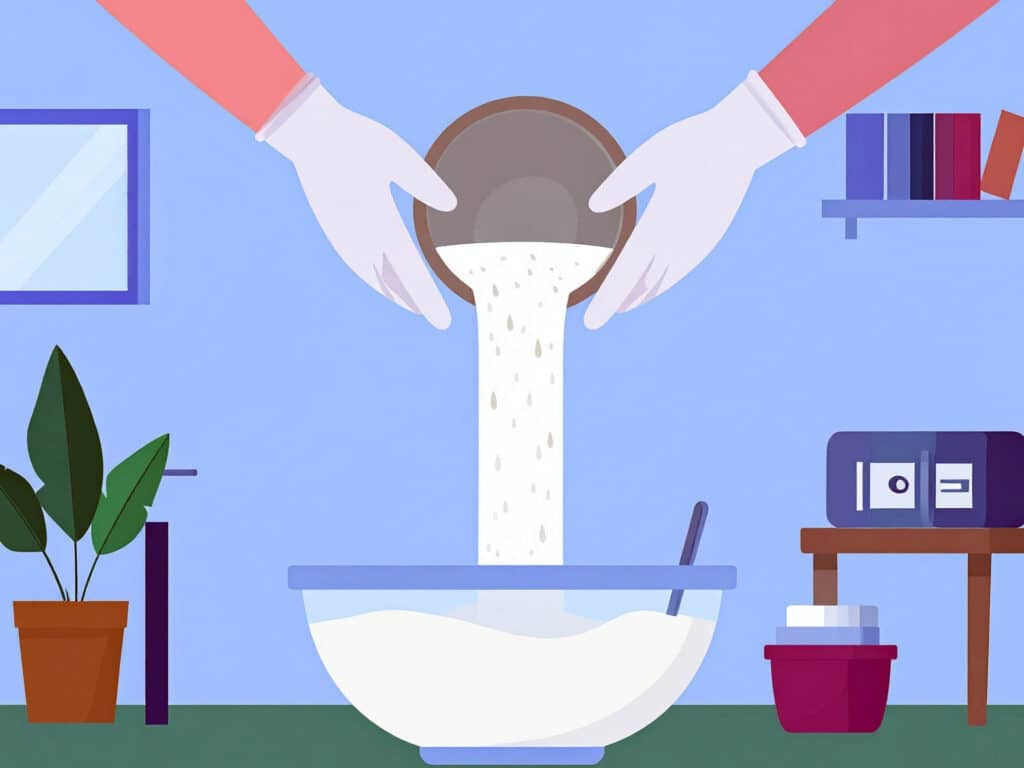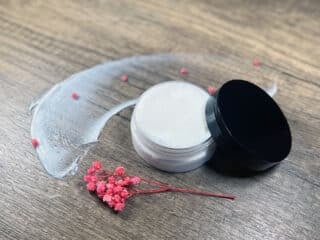I learned about titanium dioxide in soap the way a lot of us do. I was chasing that bright, creamy white bar that looks like fresh linen.
I still remember the first time I opened a bag of TD, tapped the spoon a little too hard, and sent a ghostly puff drifting across my kitchen. Pretty, sure. But the tickle in my throat told me something else.
That was my nudge to look closer at what this pigment is doing in our recipes, our bodies, and our water.

Let’s walk through what titanium dioxide actually is, why soapmakers love it, where the safety debates land today, and what I use instead most of the time.
I’ll be fair; I’ll also be honest that my formulation ethos leans away from it.
Why is Titanium Dioxide Used in Soaps?
Titanium dioxide, also called TD, titanium white, Pigment White 6, CI 77891 or TiO2, is an insoluble, natural white opaque pigment. It looks and feels a lot like flour, and it scatters visible light incredibly well, which is why it makes colors look crisp and surfaces look opaque. It’s become one of the most popular colorants on the market.
In soap, that light scattering is what turns yellowish or translucent batter into a clean white soap bar. Better yet, they are non-bleeding and do not morph in a high pH environment. In melt and pour soap, it is literally the ingredient that converts a clear base into an opaque base. Suppliers list it as the opacifier in white bases, and you can watch a clear slab flip to milky once TD is blended in.
It is also used to help stabilize color and, in other cosmetic products, it can protect against UV light, which is why TD shows up in sunscreens and bright white coatings. In food and drugs, that brightening and UV-protective behavior helps define color and slow UV degradation.

Is Titanium Dioxide A Safe Pigment in Soaps?: The Controversial Debate
Here is where it gets nuanced, and steeped in controversy.
First, context. Much of the scary research involves rats exposed to large airborne doses or nano sized particles, situations that are not the same as a wash off bar sitting on your sink.
The classic classification from IARC (International Agency for Research on Cancer) lists titanium dioxide as Group 2B, possibly carcinogenic to humans, based on inhalation studies in animals; human evidence is considered inadequate. That is a signal to control titanium dioxide dust exposure, not a verdict that every use equals harm.
Occupational guidance echoes this. The New Jersey Department of Health’s fact sheet flags titanium dioxide as a possible carcinogen and advises keeping exposure as low as reasonably achievable, especially to airborne, respirable particles.
In plain language, do not breathe the dust. Eyes, nose, and throat irritation from direct exposure is also documented.
Oral exposure has a different story. In 2021 the European Food Safety Authority reviewed titanium dioxide as the food color E 171 and concluded it can no longer be considered safe as a food additive, mainly because genotoxicity concerns could not be ruled out given particle behavior in the body, even though oral absorption is low. That is food, not soap, but it is part of the overall picture.
Dermal exposure, the one we care about for bars and many cosmetic applications, tends to look less concerning for non nano grades. The EU Scientific Committee on Consumer Safety has repeatedly found pigmentary and coated TiO2 acceptable in certain cosmetic formats. Even nano forms up to 25 percent in commercial sunscreen products for skin application, while warning about inhalation risks for sprays and loose powders.
So skin contact in a rinse off product is not the same as inhaling clouds of pigment in your studio. Still, formats that create inhalable particles, like aerosols or loose powders, demand extra caution.

One more thing while we are on safety, the skin is a door, not a wall. NIOSH reminds us that many chemicals can enter through skin and affect entire organ systems. That general principle is why I mix, pour, and clean up with gloves on, and why I keep powder handling tidy even for “wash off” formulas.
So where do I land as a formulator? For me, the combined signals, inhalation hazards during handling, food safety uncertainty, and environmental questions, tip the scales toward using TD rarely, and carefully, if at all.
But keep in mind that I came to this decision after doing my own research. I will admit, I’ve used TD before. I won’t pretend I havent. Take a look at this post I did an absolute age ago, before I knew more about this unasumming ingredient.
I won’t delete this post, becuase it’s part of the journey I’ve made, and I wouldn’t be the formulator I am today without that journey. The main take away from this post is to be as informed as possible, so you can make decisions for yourself.
How To Use Titanium Dioxide in Soaps

If you do choose to use titanium dioxide in soap, a little goes a long way.
- Typical usage, 1/4 to 1 tsp per pound of liquid oil, which is roughly 1/2 to 2 teaspoons per kilogram of oils. Start low; you can always add more. Too much can create a chalky look and pasty lather.
- Disperse before adding. I pre mix the powder in a bit of lightweight oil or glycerin, about 1 teaspoon pigment to 1 tablespoon liquid, then stick blend that slurry smooth. Water dispersions also work, but in my experience they slightly raise the risk of those pale “glycerin river” streaks if your batter overheats.
- Watch your soaping temperatures and water discount. Cooler batter and a modest water discount help minimize rivers and mottling when you use TD. That trick saves the day more often than the amount of TD you add. Furthermore, TD is can be annoying, because it loves to make ‘glycerine rivers’ in your soaps at high temperatues. If you notice these problems, consider combining your lye and oils 10 degrees lower than you ordinarily would.
A small confession, the one time I rushed and sprinkled TD straight into my emulsion, I chased tiny white specks for ten minutes and still found ghost freckles in the cured bars. Premix. Your future self will thank you.
Safety precautions I actually use
- Wear a snug mask or respirator while measuring the powder, then cap and put it away. No loose jars lingering open.
- Mix the slurry really really slowly to keep dust down, like as slowly as you can. Then add to your batter.
- Clean up wet. Wipe with a damp cloth rather than sweeping dry, which just redistributes pigment into the air.
- Choose non nano, pigmentary grades and avoid spray formats.
Titanium Dioxide in Soaps, The Process
If you want a truly bright white color in a cold process bar, titanium dioxide will get you there. It is the shortest path.
- Add the premixed slurry at light trace, blend well, and pour.
- For layered designs, I often color only the portions that need to be bright white and leave the rest natural, which cuts the total amount used.
- In melt and pour, you can buy an opaque base that already contains titanium dioxide as the opacifier. If starting from clear base, any TD addition you make is essentially recreating that base.
Titanium Dioxide in Skincare
You’ll notice that TD has a wide variety of applications. Outside soap, TD shows up in sunscreens, pressed powders, and tinted creams. It provides hiding power and UV light protection. Regulators carve out different safety lines depending on exposure.

For skin applied sunscreens, pigmentary or coated nano TiO2 has been considered acceptable up to 25 percent because skin penetration is minimal, while products that create inhalable particles, like loose powders and aerosol sprays, are tightly limited for inhalation risk. If you are formulating beyond soap, read those opinions closely and design accordingly.
Natural Alternatives
I reach for these first, as great alternatives to TD
- Zinc oxide, it is the closest in performance. It whitens better than clay and usually plays nicely with fragrance oils. If I need the brightest white without TD, this is my pick. Take a look at my DIY powdered blush recipe, I use zinc oxide here.
- White kaolin clay, lovely slip, gentle feel, a soft eggshell white rather than paper white. It dulls vibrant colors a bit, which can be a feature for muted palettes.
- White micas, technically pigments on mica platelets. They can add a pearl cast rather than a flat white; sometimes that is exactly the look.
- Take a look at this homemade eyeshadow pallete recipe I whipped up a few years ago. It’s using all of the three recommendations above to produce a powdered base that I can then add to. Sometimes a combination of all three can work wonders.
- Formulate for a whiter soap base. Lard soaps, tallow soaps, or bars heavy in light oils like rice bran and high oleic sunflower often cure to a naturally pale cream. Also remember that some fragrance and essential oils shift color, especially anything with vanilla, so your whitest bar starts with careful scent choices. But formulation can be complicated. Luckily for you, my brand new Natural Soap Making Course keeps the science and artistry of soap formulation at its core.

None of these match TD’s pure, opaque punch. But I rarely need that level of white, and I like the tradeoffs.
What other products contain titanium dioxide?
It is everywhere once you start looking. Paints, coatings, plastics, paper, toothpaste, pressed powders, lip balms, and historically in foods and pills as an approved colorant in some countries.
In the United States it remains a permanently listed color additive for foods, drugs, and cosmetics with restrictions, for example foods not to exceed 1 percent by weight. In the EU, E 171 was withdrawn from permitted food additives in 2022 after the 2021 EFSA opinion. Two different regulatory approaches, which tells you the science is still being parsed.
Environmental thoughts that keep me cautious
Even though titanium dioxide is insoluble, the small particle sizes used industrially can behave differently out in the world. Studies report toxicity to certain aquatic organisms at relatively high concentrations, and nanoparticles can accumulate or move through food webs under some conditions. Thus, this substance has the potential to cause serious adverse effects in our waterways.

Some reviews say risk looks low in general waters yet flag hotspots near discharges as a concern. Because soap is a global wash off product, I prefer to reduce any pigment that might contribute to that load.
Industry sources also acknowledge that TD production and waste streams can impact water quality unless tightly controlled. That is not about your bar directly, but it matters to me as a buyer and formulator.
So, should you use titanium dioxide in soap?
You can, and many do, safely and beautifully. If you are going to, keep your powder handling tidy, minimize inhalation, aim for low effective usage, and consider pigment choices that avoid nano forms. If you are comfortable without it, formulate for naturally pale bases or use zinc oxide and clays to nudge the color toward white. Both paths are valid.
And because scientists keep reevaluating what is and is not safe, stay curious. A short quote I keep pinned above my workbench from EFSA’s 2021 communication, titanium dioxide “can no longer be considered safe” as a food additive. Different context, same reminder. Keep checking the evidence; adjust when the facts do. European Food Safety Authority
Quick mistakes to avoid
Tip: There’s not a great substitute for baking soda, but finely ground oats or rice flour can work – both of which are great for sensitive skin.
- Dumping dry TD straight into batter, hello clumps; premix wins almost every time.
- Chasing pure white with huge amounts of pigment, you will trade lather quality and risk chalkiness. Start with 1/4 teaspoon per pound of oils, then reassess.
- Ignoring dust, even a tiny cloud is avoidable. Mask up for the minute you measure, then relax and enjoy the pour.
Final Thought
If you want a bar that looks like freshly fallen snow, titanium dioxide in soap will do it. I just prefer my snow a little creamier, and my studio air a little cleaner.






